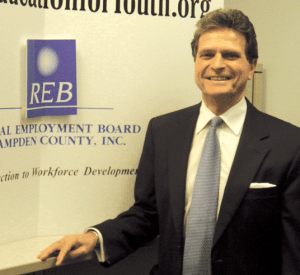
No Youth Movement
Labor-market Report Highlights the Region’s Skills Gap
 Bill Ward calls it a “mismatch.”
Bill Ward calls it a “mismatch.”
There are other words being used to describe the region’s job market, none of them particularly enthusiastic. But to Ward, president and CEO of the Regional Employment Board of Hampden County (REB), it boils down to an ever-present skills gap.
“It all comes back to this huge, complex issue we have: there are skills shortages, and there are people who are looking for jobs and can’t find them,” he said. “There’s a mismatch out there. There always has been, but now it’s more pronounced because today’s jobs require a higher skill set.”
Ward was responding to a report — “Labor Market Trends in the Pioneer Valley Region” — recently issued by the Commonwealth Corp. and the New England Public Policy Center of the Federal Reserve Bank of Boston. That report paints a picture of a naggingly high — albeit slowly falling — unemployment rate in the region, but also a labor pool that’s not adequately equipped to fill the job openings that do exist, which creates a problem for companies looking to grow or locate here.
This trend is exacerbated, the report notes, by an aging population and, in some fields, potential future shortfalls of workers with the skills and education required by employers. In 2008-10, the period the report focuses on, 47.1% of the labor force was age 45 or older, while only 31.6% was 34 or younger.
And while the region’s residents have, on average, increased their level of education over the past decade, progress in that area has been slower than in other regions, leading some economic-development leaders to wonder whether the younger generation will be adequately equipped to replace the masses of retiring Baby Boomers over the next decade.
All this isn’t news to Ward, who deals every day with the challenges of the Pioneer Valley economy and strategies to boost it.
“It updates the reality and confirms it,” he said, noting that the report offers plenty of data but few solutions. “These are complex issues; you can’t just flip a switch. What keeps me up at night is the quality of this workforce and what it needs to do to be competitive. If anything, this report emphasizes that.”
Youth Is Not Served
Robert Clifford, an economist and public policy analyst for the New England Public Policy Center, took part in a roundtable recently at Holyoke Community College to discuss ther report’s findings. He noted that the region’s working population between ages 16 and 24 actually fell from 51,988 in 2000 to 49,788 in 2010 — the only region in the state where that occurred.
Clifford broke down the report’s findings into four main points:
• After nearly a decade of declining employment, the Pioneer Valley is recovering at a modest pace, but continues to have one of the highest unemployment rates statewide;
• An aging workforce, declines in younger workers, and a stagnant population will force the region to confront demographic challenges sooner than other regions;
• Despite gains in the educational attainment of its labor force in the past decade, the Pioneer Valley still has the highest share of individuals with only a high-school degree or less; and
• Addressing the barriers to employment facing the region’s
jobless population, particularly among the young and less educated, is key to the Pioneer Valley’s economic vitality moving forward.

Bill Ward says businesses shouldn’t wait for the perfect candidate for a job, but be willing to train a talented learner.
It’s a message framed by an air of overall sluggishness on the job front locally.
“While the employment rate in the region was nearly the same as the rate statewide through the first half of the past decade, the impact of the Great Recession was particularly severe in the Pioneer Valley,” the report states, noting that the region’s unemployment rate reached 9.2% in 2010, slightly below the national rate of 9.6%, but far exceeding the statewide rate of 8.5%, making it the third-highest jobless rate among all regional labor markets. It also represents a much higher rate than the 3.0% recorded in 2000 and the 5.8% posted in 2003, following the 2001-02 recession.
Perhaps more troubling, however, is the report’s repeated emphasis on how young workers are being impacted. In 2008-10, more than 50% of the region’s unemployed were 34 years old or younger, though such individuals accounted for just 32% of the region’s workforce. Meanwhile, 60% of those unemployed in the Pioneer Valley had a high-school degree or less, while only 38% of the region’s workforce had such an education.
That points to multiple demographic trends that intersect in a troubling way. While the Pioneer Valley’s workforce skews higher in age than other regions, the younger generation isn’t always ready to compete for the jobs that do, and will, arise — the very definition of a skills gap.
“Massachusetts is one of the most highly educated states in the nation, but the Pioneer Valley’s residents and workforce … have education levels similar to their counterparts in the United States,” the report asserts. “Over the past decade, the region has seen progressively higher levels of educational attainment among its residents and workforce, but a high-school degree continues to be the most common level of educational attainment in the region.”
Specifically, in 2008-10, the share of the region’s labor force with a bachelor’s degree or higher (30.5%) trailed that of Massachusetts as a whole (41.2%). However, when the figures are calculated to include all workers with some kind of post-secondary education, the Pioneer Valley (67.8%) closes the gap somewhat on the state (67.8%), due to a larger concentration of individuals with certificates or associate’s degrees, perhaps reflecting the strong presence of the region’s community colleges.
Training from Within
The persistent skills gap, the report notes, “may be particularly troublesome given that 91.5% of the region’s employees are also residents. The Pioneer Valley may not be able to attract workers from other regions to work in jobs with relatively low education requirements and pay, given that those populations are typically filled by less mobile populations.
“However,” it continues, “younger workers and those with lower levels of education, who are disproportionately unemployed, may provide a future supply of labor that can be educated and trained to address labor shortages.”
To foster economic growth in the future, the report argues, the Pioneer Valley should “strive to align the education of its labor force to meet the demands of the region’s employers” — a call to colleges to step up efforts to draw students into degree programs for in-demand careers, like those in the STEM (science, technology, engineering, and math) fields.
Although Ward has been involved in many such initiatives to boost worker training in the region, he notes that colleges, career centers, and other economic-development entities can’t do it themselves.
“There’s an insidious dynamic in the job market where employers say, ‘I have jobs, but I can’t fill them; I can’t find skilled workers,’” he noted. “But these employers need to do some rethinking about training. They need to do it on their own. This idea of looking for a perfect candidate … the workplace is changing, and there’s no such thing as an off-the-shelf worker. You can’t expect that.
“Because of the complexity of the marketplace today, employers need to be more engaged in preparing their future workforce,” Ward continued. “They need to do more on-the-job training and engage with educators to create career pathways for young people, so when they’re in school and see the applications of math, science, and technology in the workplace, there will be less dropping out, and more kids turned on by seeing the connections between school and work. It’s a complex issue, and there is no single solution.”
Despite the presence of a “feeder system” in the form of multiple well-regarded colleges, plus the state’s flagship university campus, Western Mass. has long had difficulty holding on to graduates, he noted. “We’re seeing large numbers of young people not being retained in this region, and the reason for their outmigration is that we have not been able to generate employment opportunities for these young people.”
Part of that, he said, is due to generally lackluster job creation over the past three years, which has hit young people hardest, particularly in the realm of summer jobs, which provide much-needed experience and develop workplace skills. “Young people, up to age 25 or so, have been bearing the brunt of the recession, so to speak, and to get that first job, they’re tending to be more mobile and look elsewhere; we see them crossing into the Boston area and other markets.”
Meanwhile, older workers are holding on to their jobs longer, in many cases due to the financial meltdown of 2008 and the downturn that followed, which exacerbates the problem young people have finding work.
But the aging of Massachusetts will eventually provide opportunities for the young, Ward said, and it’s incumbent upon the region’s employers, educators, and economic-development leaders to turn those opportunities into a more vibrant hiring culture.
“We’re going to need to fill these positions of the job leavers who are maturing, and the people who fill them are going to need the right skills.”
Ward noted that fewer than half of all recent college graduates in the region are currently working in their degree fields. While troubling in some ways, that statistic also means there are plenty of smart, talented young people who have the aptitude to change careers if given the opportunity by proactive employers. But instead of cultivating their own pipeline of talent, “many employers say, ‘let someone else do it,’ and they wait at the end of the pipeline for someone with their specs.”
The question, he said, is “do you keep turning away from your door the person who could potentially do the job, but doesn’t have all the skills yet? We need some rethinking by employers.”
Opportunity Knocks
There’s a tidbit buried in the labor-market report that offers a bit of optimism. “After two recessions and a decade of declining employment, the region is now gaining jobs and recovering at a modest pace. Moreover, the recent recovery from the Great Recession has been somewhat stronger in the region than in the state as a whole. The Pioneer Valley has experienced relatively broad-based improvement, with stronger growth than the state in a majority of industries.”
Combined with that outlook, the region’s demographic trends — notably, the massive Baby Boom generation approaching retirement — may seem to bode well for younger workers, Ward said, but the skills gap remains, and it threatens the growth of current businesses and hinders others from moving to Western Mass.
“Companies looking to relocate look at the labor supply,” he told BusinessWest. “We need to be willing to say, ‘we can’t afford to waste a single young person.’ We have to get as many people as possible to their full potential.” n
Joseph Bednar may be reached at [email protected]





